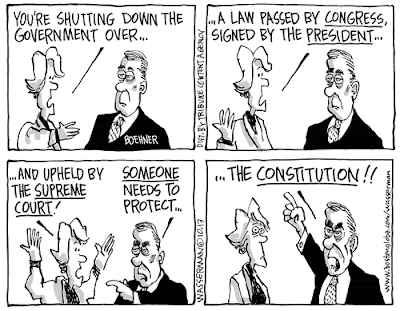Negos[1]
Fiddle while DC is frozen: no health care for Jesus
I came
across the following political cartoon shortly after a colleague recently
solicited my views regarding the current government shutdown. It succinctly
expresses my assessment of who is responsible for the present impasse.
A fuller
answer would address the question how and why this shutdown came to be. Here
goes.
Tea
Partiers comprise about a tenth of the House of Representatives and roughly 20%
of the Republican House majority. The political cowardice of the GOP leadership
to confront its most reactionary wing time and again leads Speaker Boehner’s
team to abdicate control of the People’s House to this tiny minority of
Congressmen. Rather than marginalize these bullies through an act of leadership
and statesmanship, the Speaker chooses capitulation time and again so as to
avoid provoking primary challenges. He apparently does not apprehend that
virtually all of the Tea Party representatives come from heavily gerrymandered districts that have been largely scrubbed of nonwhite voters. It would be hard
for most states to create more of such districts in the next redistricting
go-around, and increasingly impossible to maintain such districts in view of
the country’s present demographic trends. But short-term expediency is breeding
big-time, long-term adverse consequences for both the nation [certainly] and
the GOP [probably].
While I
have mentioned the racial composition of the districts of which the Tea Party
has secured present political control, I have not spoken of the racial animus
of its members and its policies. To do so usually provokes irrational and
cynical nonsense about “playing the race card”.
But let us consider these few facts drawn from the historical record.
1.
Affirmative action has always been a part of
America’s history. Until the Civil Rights Movement the primary benefits of
affirmative action were white men. This is incontrovertible before the New Deal
of the 1930s. But even New Deal legislation reinforced favoritism based on
race. One example of many: Social Security legislation was drawn to exclude
those occupations to which most black people, especially black women, were
relegated. This was a political compromise by the Franklin Roosevelt
administration to achieve the greater good. Black people paid the lion’s share
of the cost at the time and still do. [Not unlike that 3/5 of a person
compromise that made possible the birth of a nation. Who benefited from that?
Who paid the price of that ticket?].
2.
The primary beneficiaries of modern civil rights
legislation have been white women. Not begrudging them. I’m just saying. Tens
of millions of black people have benefited from the legislation. Over a hundred
million white women have benefited from it. Of course, the real beneficiary has
been the entire nation.
3.
A higher percentage of black people has been
uninsured than white people. The black community needs the Affordable Care Act.
But, just as in the preceding paragraph, more white Americans will benefit from
the ACA than black folk. No problem. The whole nation benefits.
And while we’re on this point, I would venture that Tea
Partiers are among the most vociferous defenders of the claim that the USA is
the greatest nation on earth, [with the best health care system, the purest foreign
policy, the most valorous military, etc.] But how do they explain that the US
lags virtually the industrial world in enacting universal health care? Or that
our pre-ACA system has led to the world’s most expensive system while
simultaneously being one of the world’s most inequitable? [Check out this eight-minute
video on health care costs in America.]
So why
this excursion into talk of race? I personally lost interest long ago in
calling people racist for their actions or beliefs. I think we need a new
way of talking about issues of race that permits us to address causes and
conditions and remedies without making accusations or assigning individual
blame. Nevertheless, it is appropriate to point out that certain people
consistently adopt positions that have disproportionately negative consequences
for people of color. And when the Speaker of the House, a la Pontius Pilate, throws up his hands and lets the mad crowd
have its blood, he can’t claim clean hands.
[1]
When I was in prep school, “nego” was a
term applied to people who were consistent naysayers, for whom opposition
seemed a natural reflex.


